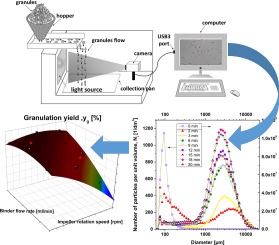Wet-granulation process: phenomenological analysis and process parameters optimization

Wet granulation is a size-enlargement process applied in many industrial fields, such as pharmaceutical, nutraceutical, zootecnichal, to improve flowability and compressibility properties of powders. In this work analysis of the particle size distribution (PSD) of granules was performed to understand the phenomena involved during the granulation process and to optimize the operating conditions. Hydroxypropyl methylcellulose (HPMC) granules were produced spraying distilled water as liquid binder on powders in a low-shear granulator. The experimental campaign was planned using the full factorial design statistical technique varying two factors (impeller rotation speed and binder flow rate), each at three intensities. PSDs of HPMC granules at different granulation times were obtained by an ad hoc dynamic image analysis device based on the free falling particle scheme. PSD measurements showed that wet granules size depends on the simultaneous presence of nucleation, agglomeration and breakage phenomena. The process parameters optimization was carried out using response surface methodology (RSM) and using the granulation yield (% w/w of wet granules within the size range 2000–10,000 μm) as the main variable of interest

